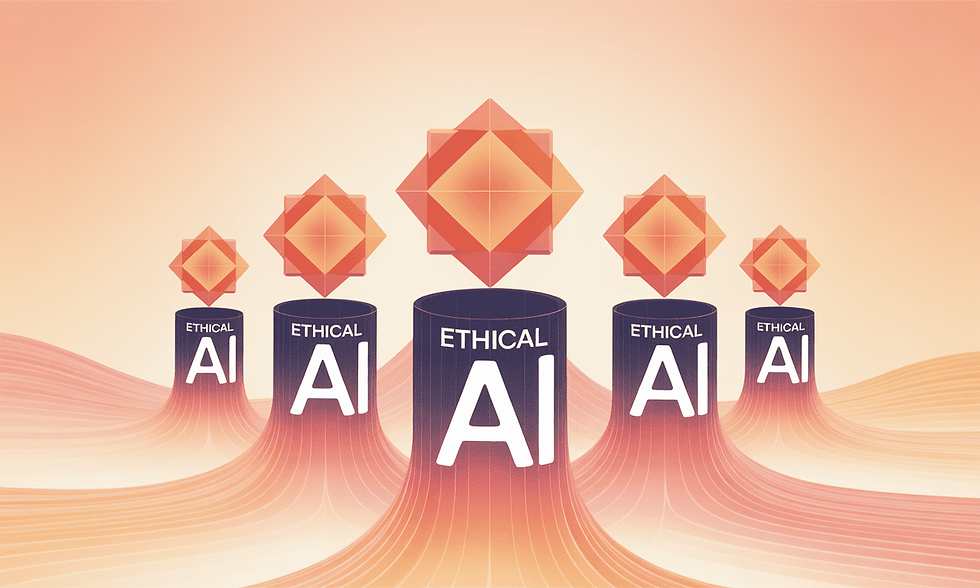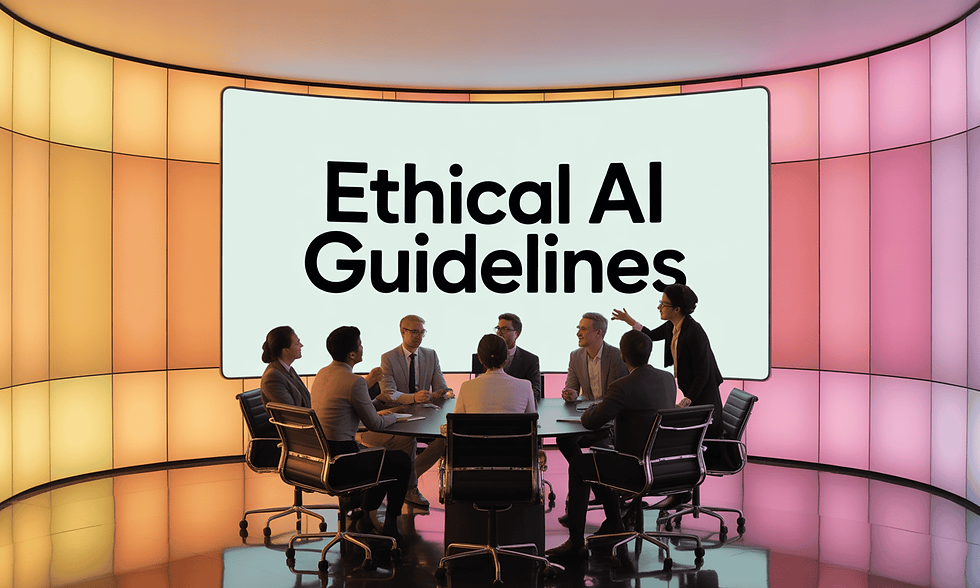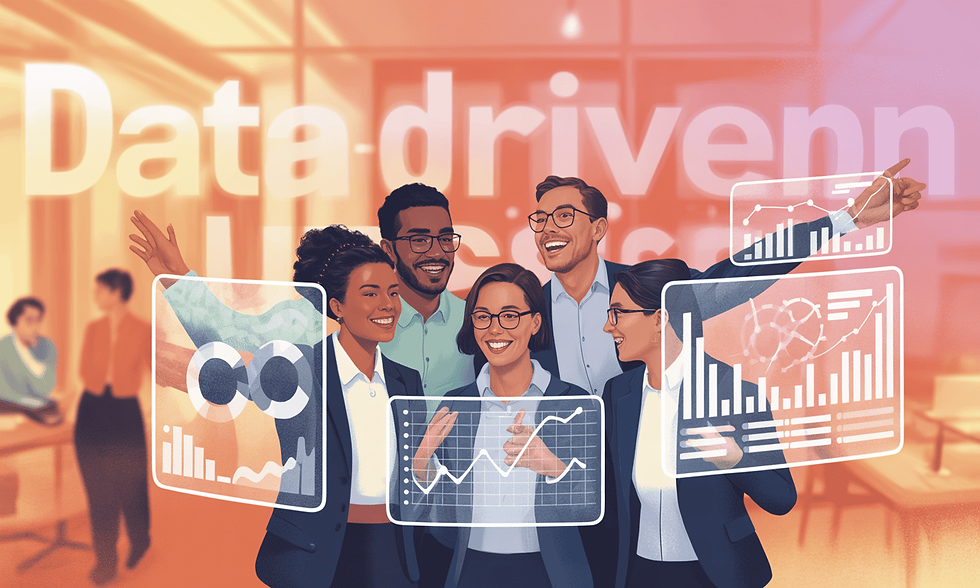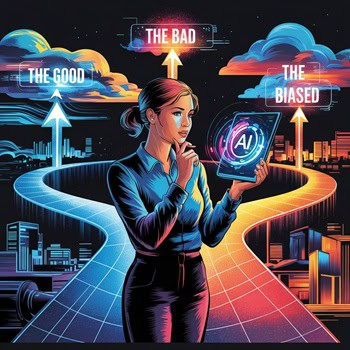AI Series 05: Building Ethical AI – A Practical Guide for Responsible Innovation
- Catherine Manin
- Jul 21
- 5 min read
Updated: Aug 25
AI is transforming how we live, work, and make decisions. From automating routine tasks to offering complex insights at scale, AI is packed with opportunities we’ve never seen before. But alongside the promise comes real ethical responsibility — one that cannot be ignored.
As AI becomes more deeply integrated in business, education, healthcare, and governance, it brings new risks: systems trained on biased data, opaque decision-making processes, and tools that might inadvertently cause harm, even when designed with good intentions.
In this post, I’ll explore what ethical AI really means — not in abstract terms, but as a set of practical, human-centered principles. You’ll also find actionable steps your organization (or you as an individual) can take to ensure that your use of AI is not just smart, but responsible.

Why AI Ethics Matters More Than Ever
For many organizations, adopting AI is seen as a competitive edge.
But rushing into it without considering ethics can lead to serious consequences — not just technical failures, but social ones too.
And we've already seen examples:
Recruitment algorithms that filter out qualified candidates due to gender or ethnicity bias. AI-powered hiring tools have favored male candidates over equally qualified women, simply because historical data reflects a male-dominated workforce.
Facial recognition systems that misidentify people of color at alarmingly high rates. Studies have shown much higher error rates for individuals with darker skin tones — a flaw that can have serious consequences, especially in policing or legal settings.
Predictive policing tools that reinforce existing inequalities, often targeting already marginalized communities based on biased historical data.
Generative AI platforms that hallucinate false information or amplify stereotypes — without any awareness of the harm they might cause.
The ethical implications of these tools aren't just unfortunate side effects — they’re embedded into how the systems work, unless addressed intentionally.
Left unchecked, these risks can damage reputations, lead to legal issues, and erode public trust in the technology itself.
But ethics isn’t just about avoiding harm or bad PR. It’s also about asking better questions:
What kind of future do we aspire for AI to help construct?
Are we merely reinforcing the status quo, or are we leveraging AI to challenge inequality and enhance access?
Are we developing tools that serve only a select few, or ones that can benefit a broader population?
Ethics is the foundation of sustainable, socially conscious innovation — and it starts early in the development process, not after the launch.

What Ethical AI Looks Like
Ethical AI isn’t just a vague ideal — there are well-established frameworks that guide us. Several leading institutions have already laid out principles that help organizations align their AI efforts with values that matter.
IBM’s Pillars of Trust
IBM proposes five core pillars for trustworthy AI:
Explainability – People should be able to understand how and why an AI system makes certain decisions.
Fairness – AI should work equally well for all groups, without bias or discrimination.
Robustness – The system should be secure and resilient, even under unexpected conditions.
Transparency – The data sources, logic, and limitations behind an AI system should be open and clear.
Privacy – Respecting user privacy and complying with laws like GDPR or CCPA is non-negotiable.
Google’s AI Principles
Google has published its own set of commitments:
Build AI that is socially beneficial.
Avoid tech that causes or reinforces bias.
Ensure human oversight and accountability.
Embed privacy protections from the start.
These aren’t just marketing slogans.
They reflect a growing understanding that technical excellence alone isn’t enough — moral responsibility needs to be built into the process.
Ultimately, ethical AI means shifting from the question, “Can we build this?” to also asking, “Should we build this — and who might be impacted if we do?"

Six Practical Ways to Build Ethical AI
Turning principles into action doesn’t have to be overwhelming. Whether you're a large company or a solo entrepreneur, there are steps you can take right now to build more ethical AI:
1. Use diverse and inclusive datasets
AI systems learn from the data we give them. If the training data reflects existing inequalities — in hiring, healthcare, or education — the model will carry those biases forward. Make sure your datasets include a wide range of identities, experiences, and perspectives.
Audit for bias at every stage
Bias isn’t always obvious at the start. It can emerge after deployment or as the model evolves. Regular audits — of both data and outcomes — are essential. Use fairness benchmarks and, where possible, involve external reviewers or ethics committees.
3. Keep humans in the loop
AI should assist human decision-making, not replace it — especially in sensitive areas like healthcare, finance, or criminal justice. Build workflows that allow human review, intervention, or override when necessary.
Be transparent and explainable
People affected by AI decisions should be able to understand how the system works. That means:
Clarifying what data was used.
Explaining how outputs are generated.
Being upfront about known risks or limitations.
This kind of transparency builds trust — and helps users make more informed decisions.
Protect privacy and data rights
Ethical AI respects autonomy. That includes:
Collecting only the data that’s truly necessary.
Being clear about how data is used.
Letting users opt out or control what they share.
Follow relevant laws, of course — but also design with dignity and respect in mind.
6. Train your teams — and listen widely
Ethical thinking shouldn’t sit with just one team. Product managers, marketers, developers, designers — all need a shared understanding of the risks and responsibilities. Offer regular training, and invite feedback from diverse users — especially those who might be impacted most.
Example: In healthcare AI, patients and frontline doctors can offer insights that completely shift how a tool is designed — often leading to better and more responsible outcomes.

From Guidelines to Action: What Businesses Must Do Now
Ethics isn't just about checking off best practices — it's about shifting how your organization works. Here’s how to start turning values into long-term action:
Set up internal governance
Establish ethics review boards or working groups that meet regularly to evaluate projects. These teams should include not just engineers but also voices from legal, HR, marketing, and even end users.
Stay ahead of regulations
From the EU AI Act to evolving global frameworks, AI governance is changing fast. Aligning your work with these standards isn’t just about compliance — it shows accountability and builds public trust.
Monitor systems over time
AI behavior can drift after deployment. Bias can creep back in. Performance can drop in new contexts. Make post-launch monitoring part of your standard process.
Think bigger than your product
Ask broader questions about the role your tech plays in society:
Does your customer service bot understand non-native speakers?
Does your content filter apply rules equally to different cultures?
Does your automation reduce jobs without offering retraining opportunities?
Every design decision has an impact. And ethical innovation means taking responsibility for that impact — not just the code.

Final Thoughts: Building Tomorrow Starts Today
Ethical AI isn’t a checkbox. It’s a continuous process that takes time, intention, and conversation.
The companies and professionals that start building with ethics now won’t just avoid risk — they’ll build trust. And in the age of AI, trust is everything.
AI can be powerful. But it’s up to us to make sure it’s also fair, inclusive, and human-centered.
The goal of ethical AI isn’t perfection — it’s responsibility. It’s about designing systems that work for people, not just for performance metrics.
The future of AI depends on choices we’re making right now: how we train it, where we apply it, and who we include in the process. There’s no quick fix — just thoughtful, ongoing effort.
Because the future of AI isn’t only about what it can do — it’s also about what it should do.





Comments